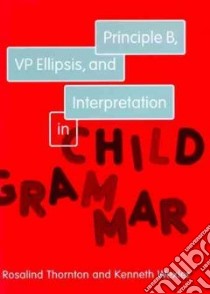Principle B, Vp Ellipsis, and Interpretation in Child Grammar - 9780262201193
Un libro in lingua di Rosalind Thornton Kenneth Wexler edito da Mit Pr, 1999
- € 10.30
- Il prezzo è variabile in funzione del cambio della valuta d’origine
Among the universal principles are those known as the principles of the binding theory. These principles constrain the range of interpretations that can be assigned to sentences containing reflexives and reciprocals, pronouns, and referring expressions. The principle that is relevant for pronouns, Principle B, has provided a fertile ground for the study of linguistic development. Although it has long been known that children make certain kinds of errors that appear to contradict this principle, further experimental and theoretical investigation reveals that the child does know the grammatical principle, but implements the pragmatic knowledge incorrectly. In fact, discoveries concerning children's knowledge of Principle B are among the most well-known in the study of language acquisition because of the dissociation between syntactic and pragmatic knowledge (binding versus reference).In this book the authors deepen and extend the results of years of developmental investigation of Principle B by studying the interaction of Principle B with verb phrase ellipsis and properties of the interpretation of empty pronouns in ellipsis--properties of "strict" and "sloppy" interpretation. This is the first experimental study of these topics in the developmental literature. The striking results show that detailed predictions from the "pragmatic deficiency" theory seem to be correct. Many novel experimental results concern the question of how children interpret pronouns, including elided pronouns, and how they understand VP ellipsis. The authors present the necessary theoretical background on Principle B, review and critique previous accounts of childrens errors, and present a novel account of why children misinterpret pronouns. The book will thus be of interest not only to readers interested in the development of the binding theory, but to those interested in the development of interpretation and reference by children.
Informazioni bibliografiche
- Titolo del Libro in lingua: Principle B, Vp Ellipsis, and Interpretation in Child Grammar
- Lingua: English
- Autori : Rosalind Thornton Kenneth Wexler
- Editore: Mit Pr
- Collana: Mit Pr (Hardcover)
- Data di Pubblicazione: 17 Settembre '99
- Genere: LANGUAGE ARTS and DISCIPLINES
- Argomenti : Language acquisition Grammar, Comparative and general Pronoun Grammar, Comparative and general Syntax
- Pagine: 241
- Dimensioni mm: 241 x 165 x 19
- ISBN-10: 0262201194
- EAN-13: 9780262201193


